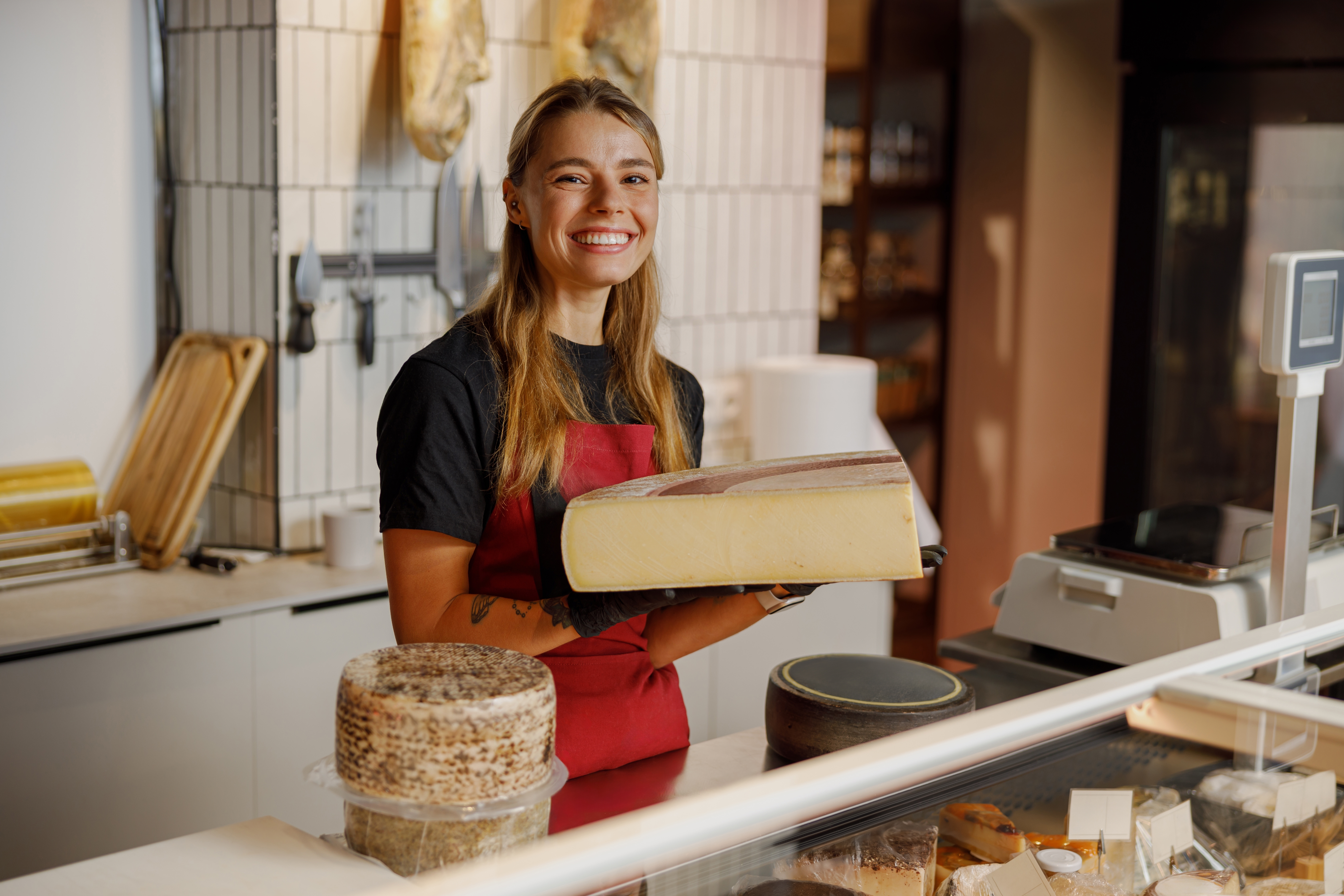Free digital copy
Get Speciality Food magazine delivered to your inbox FREE
Get your free copy
As a cheese seller, you are the key, final gatekeeper of each piece before it continues its journey home with a consumer, into their kitchen.
For many, this feels like a great responsibility – especially when it comes to artisan varieties. The level of care found throughout the magical process - from the welfare of animals, to collecting the finest milk, churning and separating curds from whey, pressing, making and conjuring in the art of affinage – is astounding.
It’s your job to make every cheese shine, to understand its USP and nuances, and to deliver it to shoppers in tip-top condition.
Part of that ‘contract’ of sale, particularly in a speciality setting such as a deli or cheesemonger, is also sharing your knowledge.
One of the prime reasons consumers visit fine food specialists (other than for greater choice) is to learn more about what’s going on their cheeseboard. The skill of a good cheesemonger is to continually educate themselves (and their staff), so they can give shoppers the bigger picture about what’s displayed in front of them.
To be able to converse about the maker, to tell the unique stories behind each variety, and to offer pairing suggestions adds value to the experience.
Jessica Summer, owner of Mouse & Grape, spends a lot of time training her staff to ensure they can help convey the beauty of artisan cheese to customers in store. It’s so important, she says, for that passion to come across.
Take baby steps, she recommends, when it comes to initiating new team members. “It can feel overwhelming to be faced with a big cheese counter if you haven’t worked in cheese before. As a starting point, everyone here learns the fundamentals, to understand how cheese is made, what milk is used, where it’s made and if it’s pasteurised or unpasteurised. We also make sure they have some adjectives to describe the flavour of the cheese.”
Enabling staff to come up with their own descriptions is just as important, though. Jessica encourages the team to taste things regularly when they’re on a shift so they can “see how things evolve and change”.
“It’s nice to be able to say to customers ‘this cheese tastes like xxx this week, or this one is a bit more mushroomy or caramelly today’.”

Jessica makes sure each cheese label has notes for staff on the back, including wine suggestions. And a brilliant device she’s introduced is giving everyone three particular cheeses to focus on in terms of knowledge and sales each week. “You can tell who’s been on shift because certain cheeses are gone,” she smiles. “We’ve got a bingo card for each member with different products around the shop, so not just cheese, but deli items and wine. Whoever gets ‘bingo’ for selling all the different items, wins a £50 voucher. It’s fun!” That competitive edge also encourages staff to want to learn more about what they’re selling, which can only be a good thing.
Something else the cheesemonger heartily recommends when training is ... Youtube! “There are so many amazing videos about making cheese – so they can see how Brie is made, or how Parmesan is made. It’s all on there.”
Should in store labels simply give the name of the cheese, leaving it up to shoppers to ask questions? Or is it best practice to deliver as much information as possible?
Dylan Fourie, deli manager at Macknade, has quite a few thoughts on the issue. It’s traditional, he says, to have a big-fonted label denoting the price of the cheese per kilogram. But that can be confusing – after all, not everyone has time to stand at the counter doing the sums. Leading with a price per 100g is more inviting, he thinks.
Beyond this, he likes to regionalise cheese. If it’s made in the UK, rather than marking it as British, he’ll pop on ‘Somerset’, ‘Suffolk’ or ‘Dorset’. Though this method doesn’t extend to continental varieties, where specific place a cheese is from could change depending on supply. Here saying ‘France’ or ‘Italy’, for example, will suffice.
“Having a brief description on the front is fine, but what’s most important is whether it’s pasteurised or unpasteurised, and what rennet is used. That will help you a lot because those are two of the biggest questions customers will ask.”
The rear of the counter’s labels will have tasting notes, usually a few suggestions staff can elaborate on. “I wouldn’t write a description of the history of the cheese, or how it’s made. In busy periods staff won’t have time to read through those. If you teach them to read descriptions off the back of a label it becomes a bit monotonous – like a script. More important is to leave space on the back for the best before date – that’s useful!”
As for the types of labelling you should use? “I see a lot of people use stick labels you pin into the cheese,” Dylan continues. “For me, they’re a big no-no. I wouldn’t touch them. If you don’t train you staff effectively, they could stab a blue cheese, then another cheese, and that will create problems. It’s better to arrange labels across the shelf edging.”
Prepackaged cheese should be well labelled, to include: the cheese name, net quantity, list of ingredients, allergen information, use-by-date, how to store, name and address of the producer, country of origin, nutritional declaration (unless a retailer is packaging pieces to sell to the end consumer in store).

Educating shoppers about cheese is one of the most wonderful jobs in the world, says cheese expert Ned Palmer, who runs The Cheese Tasting Co.
Beyond what you can convey in words, it’s ultimately the taste of the product that does the talking. A brilliant way to create engagement, and a method used by his former employer Neal’s Yard Dairy, is for staff members to ask shoppers as they enter the shop if they’d like to try some cheese with them, rather than the usual ‘hello’, ‘can I help you?’ or ‘what would you like?’.
“I still really believe in that, because as soon as you introduce amazing cheese, that conversation flows. They might say, ‘I quite like that’, and you might reply ‘it’s really buttery today, do you agree?’.” This draws them in, making them feel more part of the experience of tasting. It also fosters a sense of comfort, which is very important, thinks Ned. “The whole point is to make people feel comfortable. Most people haven’t been into a cheese shop before. They look at us in our little uniforms and feel intimidated. Also, we are in the business of selling stuff – the more comfortable they are, the more likely they are to buy something.”
Listen to your customers, but guide them using your knowledge, he adds. “By the time you get to the third tasting, you’ll start to get an idea of what they’ll like.” He gives an anecdote of this process being like taking a blind shot. You might miss to the left a bit, miss to the right, but the next time you’ll have moved into the right position. “Then you can say, ‘I think you’ll love this’. It’s a really attentive and lovely communication style.”
Controversially, Ned doesn’t think the customer is always right – and this is where the education and expertise of a seasoned cheesemaker comes in. “Someone might come in and say they’d like a particular type of Cheddar. They probably like it because it’s strong. But the ‘can I try these with you?’ approach allows you to figure out what they really want.”
As a pro at hosting tastings, Ned also has plenty to say on in-store events, which many are investing in.
His first, and he says most “brutal” opinion, is that ticketed tastings are “a rubbish way to make money”. “The amount you have to charge to make a profit out of doing it is about £100 a head, and that’s hard to do outside of London. The point for most delis is to showcase products, to get people into the shop, and maybe sell a few bits and bobs at the end of the evening. But in the end, I’d be really brave about it and think, these events are more about getting people to see your range and to create enthusiasm for the cheese. See them as a loss leader.”
Use tasting events as a way to share more detailed knowledge of cheese, he says. “You can talk about seasonality, so things like the fact you won’t get a lot of fresh goats’ cheese in winter, but will in summer. They like that. And in the lead up to Christmas, tell them more about Stilton and the big Cheddars.”
Ned advises allowing 15g to 30g maximum pieces per cheese per person, adding that your displays at events should look generous. “How many depends on your budget. You need around six to eight to cover a good range of styles.”
Don’t forget to educate event-goers on cheeseboards while they’re your captive audience, Ned concludes. “The textures and varieties they could include. What you could upsell.” Then, when they return to your shop, they’re armed with knowledge and ideas, ready to buy.
Make sure you teach new team members:
- Food safety and hygiene
- How to properly handle and store all cheeses
- How to identify if a cheese is at its best, or needs replacing
- How to cut all varieties of cheese safely, including opening large, hard-rinded cheeses, and using a cheese wire
- How to glass wrap cheese
- The best way to arrange cheese in the counter
- Cleaning of the cheese fridges and storage areas
- Wrapping different types of cheese at the point of sale
- The difference between styles of cheese, how they’re made, and tasting notes
- How to interact with customers during sales and tastings
- Products they can upsell with a variety of cheeses